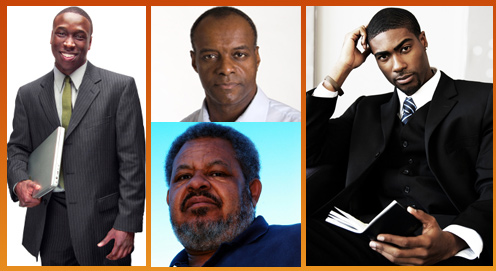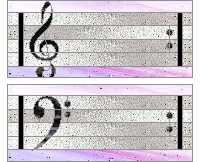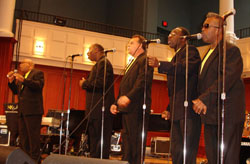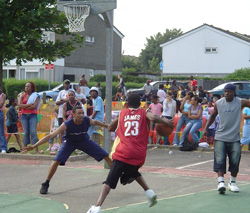Cultural Resources

MENíS DAY
CULTURAL RESOURCES
Sunday, August 1, 2010
Ralph Wheeler, Guest Cultural Resource Commentator
Long time civil rights activist, Oakland, CA
I. Historical Underpinnings
This liturgical moment, as indicated by todayís lection, points to the holy and positive characteristics of black men. It highlights those traits in black men that are good, loving, righteous, and peaceful.
Historically, Menís Day has been a time for the black church to place a spotlight on, call out and set apart menómen whose works and lives stand as Christian examples for others to follow. Their very examples can draw others to Christ.
Menís Day is a time to celebrate men. Itís a time to appreciate menís contributions to family, community and country. It is a time to use our gifts, institutions and cultural resources to benefit the internal church and the external community. And, it is a time to thank God for lessons learned, battles won and graces given.
God created man in his own imageóholy, righteous and unblemished. Therefore, Menís Day, in the black church, is a reminder to all not only of what was, but what is possible for the community of man. A great and wonderful potential lies within reach of the male, human community. Menís Day, while celebrating the past and present, always points to that potential and that hopeful future.
Menís Day has also always been a time when the special talents of the congregationsí men are put on display. Moreover, the entire service from top to bottom is usually conducted by men. It is a time when men allow themselves to become full instruments of the Lord, as called for in the lection scripture.
II. Songs That Speak to the Moment

Every significant moment in the black church, from Christmas to Easter and birth to death, has its own body of music and list of songs that the church uses to underscore the meaning and purpose of the day. Menís Day is no different.
The particular body of music and list of songs for Menís Day are to a great extent determined by the denomination, congregation, pastor, and music department of each church. Yet, there is some music and there are some songs that are congregational crossovers ó they are used by numerous denominations and churches. Often, they are songs and music that have withstood the test of time; or, they are popular favorites that speak to the current needs of the black community and the black church. The following two songs speak to the power and promise of Christian men:
Satan, Weíre Gonna Tear Your Kingdom Down
Satan, weíre gonna tear your kingdom down.
Satan, weíre gonna tear your kingdom down.
Youíve been building your kingdom all over
this land. Satan, weíre gonna tear your kingdom
Down.1
Sign Me Up
Sign me up for the Christian jubilee, write my
name on the roll. Iíve been changed since the
Lord has lifted me. I want to be ready when
Jesus comes. When Jesus comes, oh, the
trumpet will sound loud, when my Savior
comes, all the saints in Christ shall rise, Oh,
Iíve been changed since the Lord has lifted me,
I want to be ready when Jesus comes.2
The following song speaks to the yearnings of Christian men:
†
Give Me a Clean Heart
Give me a clean heart so I may serve thee.
Lord, fix my heart so that I may be used
by Thee. For Iím not worthy of all these
blessings. Give me a clean heart, and Iíll
follow Thee.
Iím not asking for the riches of the land.
Iím not asking for the crowd to know my
name. Please give me, Lord, a clean
Heart, that I may follow thee. Give me a
Clean heart and Iíll follow Thee.3
This final song speaks to the expectations that God has for all men and the needs that await them:
Here Am I
God has no hands but those that strive to mend
the broken hearts of wounded kin, God has no
feet but those that stride to win another soul to
enter in!
God has no eyes but those alert to see some-one
distressed, some soul in need, God has no voice
unless we yield to be a vessel willed to boldly sing!
Godís call is now for us to build and keep the
Living Church, Christís Bride to be, so we must work
and sow the seeds and trust Godís promises to reap!
Here am I, Lord send me. Here I am, Iíll heed your
voice, obey Your will. Here am I, Lord, send me.
Here am I: I will gladly do Your bid! I will gladly do
Your bid!4
III. Remembrances of Menís Day Past

Over the years, I have witnessed and participated in numerous Menís Day programs in many different congregations and in several different denominations of the black church. Each was different; but, in many ways, they all were similar.
For example, almost all of them had a chosen theme that focused on the importance of the contributions of Christian men. Usually, there was: a male chorus; male representation of the usher board; male church announcer or master of ceremonies; male finance team; male preacher or speaker; male program participants; and, male choruses from other churches.
Sometimes, an individual was selected as ďMan of the Year.Ē At other times, awards were given to several men whose lives and contributions in the church or community were bright lights. And, the program for the day often had either a major fundraising goal, or some other important, special church project (e.g., new church roof, physical upgrade of the parking lot or youth center, stained glass windows, or new benches) associated with the day. In each instance, the fundraising goal or special church project mostly focused on the churchís internal needs and comforts.
In other instances, some congregations have assembled all male members of the congregation, with the youngest males being led into the assembly by the older males, and conducted a menís march into the sanctuary on Menís Day. This powerful cultural display of the male species was reminiscent of scenes of African tribal leaders making their march into some important gathering or a group of young African boys returning to the tribal community during their initiation into adulthood. Other congregations have held male prayer breakfasts, retreats or seminars.
An additional component of each Menís Day program that I have experienced has been the celebration aspect of the day. In all instances, the dayís music, sermons, speeches, poetry, prayers and special ceremonies provided a high worship and praise experience. Often, hidden talents were exposed that many did not know existed within the congregation and an unusual sense of unity prevailed. All of this was overlain by a strong spirit of commitment and gratitude.
IV. Moving Beyond Celebration
Regardless of the cultural and historical underpinnings of Menís Day and how it has been historically celebrated in the black church, the needs and conditions of our communities, churches and peoples dictate that we men move beyond mere celebration and the current financial needs of the institutional church. These are fine and laudable goals to reach, but they are not enough.
Todayís lection scripture exhorts men to be cleansed disciples, grounded in faith, love and peace so we can be useful instruments for the Lordís work. That work is the same work that Christ performed when he walked this earthósupporting widows and widowers; assisting the fatherless and motherless; feeding and housing the homeless and the hungry; healing the sick and downtrodden; attending to the needs of the imprisoned; and, the least of these, addressing the interests of the locked out and the oppressed; reclaiming the blind and the lost; and acknowledging and remembering our past and our triumphs. Each of these needs is our duty and each of these needs can be filled.
These duties and needs dictate that we reevaluate each liturgical moment on the black church calendar, including Menís Day, to insure we are following the dictates of Christ, and to determine if we are maximizing our efforts, resources, and works. Every available tool, including every applicable cultural resource tool, should be considered and, if appropriate, utilized. These reevaluations may lead us past the strictures of our historical chains to a new field of dreams and visions that will enable us to find solutions to current problems that cripple our personal lives, our churches, and our communities. Then, we will really have reason to celebrate, because we will have surpassed the ritualistic phase of Christianity.
V. Make Menís Day More Meaningful
At times, pastors, program planners and congregations allow approaches of the past to imprison their creativity when they develop their Menís Day programsóďwe didnít do it like that last year;Ē or, ďwhy canít we use the same format we always use.Ē Often, however, change is not only refreshing, it is good. To be effective in our service and outreach, it may be necessary to change how, when, what, and the way we program our Menís Day activities.
A. Change, Creativity and Effectiveness
In most churches, Menís Day is a single day, usually a Sunday, on the churchís calendar.† Alternatively, churches could keep the day, but prolong the moment. The week leading up to Menís Day could be a church-wide Menís Day activities preparation period. Led by the men, the church could have a different type of activity each day or evening:
- †Monday could be book night. A particular book could be read by the entire church, the men of the church, or a particular menís division of the church. The book could be analyzed, discussed and reviewed for its relevance to the black community or the black church. Some possible book examples are: (a) State of Emergency: We Must Save African American Males by Jawanza Kunjufu;5 (b) The Autobiography of Martin Luther King, Jr., by Martin Luther King, Jr. and Clayborne Carson;6 and/or The Audacity of Hope, by President Barack Obama.7
- †Tuesday could be ďHang out with Elders Day.Ē Too often, senior African American men, especially those in nursing homes and veterans, end up forgotten. Throughout the day, why not have men from your church visit all of your male elder members who are home-bound or in nursing homes. But, donít just stop there, spend time with any male elders in any facility you visit. Take current magazines, books, toiletry items to facilities as their rules dictate. College age young men should be encouraged to partner with older men of the church and go along for these visits;
- †Wednesday could be the day you visit boys and men who are incarcerated. Again,
college age young men should be encouraged to partner with older men of the church and go along for these visits. More than just carrying Bibles and preaching, go and be a presence at incarceration facilities. However, if your church is not interested in providing at least limited reentry services, these visits could do more harm than good. Most of the men in prison will be released. If you reach out to them, they are likely to come to your church for additional help. Most will need help finding jobs, addiction facilities and places to live. Discuss what you can do with your local social service agencies, and put a plan in place. At least make sure that you have comprehensive referral information to give to persons who were formerly incarcerated who visit your church; - †Thursday could be art and culture night. If the community has a museum, the church could negotiate with the museum for the church to have a ďnight at the museumĒ outing.† If there is no museum in the community, the creative works (paintings, drawings, etchings, folk works, sculptures, pottery, metal works, murals, quilts, etc.) of the congregation and local artists could be displayed and presented at the church. Art departments of local schools and colleges could be helpful with the programming of this event. Alternatively, the church could produce its own play or theatrical piece; or, it could work with local schools, colleges or drama clubs to program this event;
- Friday could be movie or theater night. This night could take place at a local movie house or theater in the community or at the church. To enhance the evening, the young men of the church, using rented, church, school or their own equipment, could be asked or commissioned to write screen plays and/or short stories and make and present them as short movies. Also, the church could produce its own play or theatrical piece; or, it could work with local schools, colleges or drama clubs to program this event;
- Saturday could be ďTaking it to the Street Day.Ē In June 2008, Pastor Freddie Clark of Shalom Church and other pastors and civic and social agencies held a March for Oneness in St. Louis. To their amazement, more than 5,000 people, mainly men, showed up for the march. Why not hold a march in your community? You can start small with a hundred or so men and boys and some women going to a selected neighborhood and have prayer for that neighborhood and spend time with the residents. Be sure to invite city officials so that if there are specific problems in a neighborhood -- violence, drug sales, child truancy, poverty, poorly kept buildings -- that those responsible for attending to such issues are on hand to address them. For more ideas on how to carry out a march, contact Shalom Church of St Louis or Central Baptist Church of St. Louis. Donít turn over your neighborhood to crime, gangs, and dilapidated buildings. Your men can make a difference but they will have to take their actions to the streets; and,
- †Sunday could be an afternoon or evening music night. Here, there are any number of possibilities: a gospel concert; hip hop gospel; jazz/blues offerings; quartet singers; folk music presentation; and/or, a full-fledged church musical. You could also feature poetry and spoken word artists. Male poets and spoken word artists within the congregation, the local and/or national community could be presented and utilized that night. The program could also include an open mic component and could be peppered with dance, mime and other creative tools to enhance evening. The event could be compiled in DVD or CD format and given or sold to the congregation and the broader community.
Often, books are available in audio formómaking it easy for those congregants with vision or reading disability issues. Audio and visual aids, such as background music, short movies, and power point presentations, can be used to enhance the book discussions. Depending upon the churchís budget, authors, including local writers, could be included in the Monday Night book program;
B. Beyond the Church Walls

Congregations should consider extending the reach of their Menís Day programs. These programs should be viewed as opportunities to expose, serve, grow and witness. As such, churches should explore how their Menís Day programs can reach the greatest number of people, especially men folk.
Externalizing the Menís Day program would be a first step. For example, the entire Menís Day program, where physically possible, could be moved out of the sanctuary to the grounds of the church or to various venues in the local community. This would signal a spirit of openness to the general community.
Being purposeful and intentional about the use of cultural resources to enhance the scriptures, music, sermons, prayers, speeches and program activities for Menís Day would be an important second step. For example, movies could be shown on the outside walls of the church. Dance performances, musical presentations, plays, storytelling events and other cultural offerings could be presented in the sanctuary, on outside stages, or on the grounds of the church. And organized sporting games could be arranged at different venues in the community. Too, a community parade, using only boys and men, could be initiated. And a menís cook-off could be held to feed the congregation and the community.
In addition, churches could consider partnering with veterans groups, homelessness agencies, prison officials, prison teams, senior citizen facilities, websites, newspaper, and/or radio and television stations to reach and invite the aged, homeless, veteran and prison communities to attend, participate in, listen to, view and/or experience their Menís Day program activities. Each churchís Menís Day activities can be audio and video taped so they can be shared with members of those external communities. The rich cultural and spiritual food on the Menís Day menu can be programmed to have healing, regenerative, restorative, reinvigorating, and saving powers for these communities.
C. †Health Fairs and One Stop Centers

Moving beyond celebration also means recognizing and understanding that Menís Day is also a time churches can use their clout, know-how, facilities and resources to help meet the broader human and social needs of the larger community. With sufficient lead time, congregations and Menís Day program planners can organize and hold health fairs for their congregations and the larger community.
Using licensed medical professionals, medical screenings can be conducted, examinations can be provided, information can be given and referrals can be made. Since these type fairs are becoming commonplace, medical providers, insurers, health professionals, clinicians, counselors, medical equipment providers, and elder care providers and workers will usually participate. Many will volunteer.
Similarly, churches on Menís Day can establish one stop centers and invite employers, social workers, educational institutions, utilities, government agencies, health care institutions, lawyers and other professionals to provide assistance, information, especially information focused on men, and help for members of the congregation and community.
Congregations can utilize any or all of the cultural activities described in Section V above to market the Menís Day activities and to entertain the attendees and participants.
Too often the black church is attacked and criticized for being too internally bloatedófor being intuitions that do too little for black community and for being institutions that abuse black people. These criticisms, whether fairly or unfairly made, can be overcome if the church uses every opportunity on its liturgical calendar, including Menís Day, to reach out to and help the broader community. Reliance upon available cultural resources that enhance the churchís historical calendar and mission is one way of achieving that goal.
VI. Conclusion†
Menís Day is a perfect time for the black church to remember that many people, especially those in prisons, hospitals, homeless encampments, mental wards, jails, and dreary senior citizen rooms, may never see the beautiful art work of the churchís Menís Day program; and, they may never listen to the Menís Day festivities on the radio or television, neither may they read the related messages on the churchís internal bulletin boards, or even the internet.
Therefore, to reach more of these souls and to be more effective and inclusive in their ministries, churches should move beyond waiting for the people to come to them on the day of their annual Menís Day celebration. They should embrace the body of available cultural resources that will help them enhance their Menís Day programs, reach the broader community, and more effectively carry out their mission.
Again, on Menís Day, in the words of Margaret Walker, from the poem ďFor My People,Ē ďLet a race of men now rise and take control.Ē8
Notes
1. African American Heritage Hymnal. Chicago, IL: GIA Publications, 2001. #485
2. Ibid., #192
3. Ibid., #461
4. Ibid., #466
5. Kunjufu, Jawanza. State of Emergency: We Must Save African American Males. Chicago, IL: African American Images, 2001.
6. King, Martin Luther, Jr., and Clayborne Carson. The Autobiography of Martin Luther King, Jr., New York, NY: Free Press, 2001.
7. Obama, Barack. The Audacity of Hope: Thoughts on Reclaiming the American Dream. New York, NY: Crown, 2006.
8. Walker, Margaret. ďFor My People.Ē The Norton Anthology of African American Literature.† New York, NY: W. W. Norton & Company, 1997. p. 1573.



